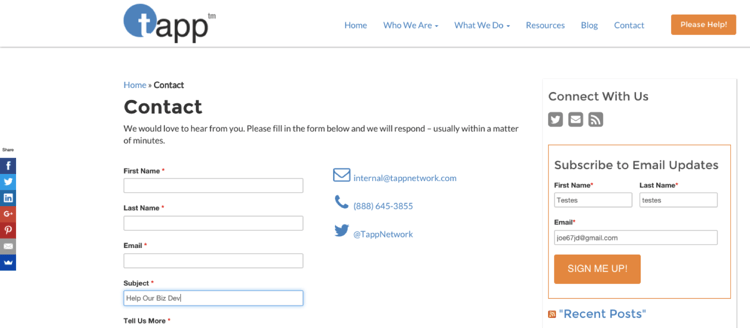
We've all been through it. The moment you're about to dig into the best darn pile of spaghetti and meatballs you've ever seen. Just as you twist your fork in the pasta, spear a mouth-watering meatball, and go in for the first savory bite ... the phone rings. "May I speak to Mister or Mrs Doe.....?" says the outbound sales rep on the other end. "This is an important message regarding your oven preferences."
This frustrating interruption is exactly why we're here to discuss inbound lead generation -- a solution that can save your salesperson, business or organization from being that annoying, disruptive cold caller who is ruining spaghetti nights for pasta lovers around the world.
What is a lead?
Let's start with the basics. A lead is a person who has in some way, shape, or form indicated interest in your company's product or service.
Meaning, instead of getting a random cold call from someone who purchased your contact information, you'd hear from a business or organization you've already opened communication with. For example, perhaps you took an online survey to learn more about how to take care of your car. If you got an email from the auto company that hosted the survey on their website about how they could help you take care of your car, it'd be far less intrusive and irrelevant than if they'd just called you out of the blue with no knowledge of whether you even care about car maintenance ... right?
And from a business perspective, the information the auto company collected about you from your survey responses would help them personalize that opening communication to meet the existing needs of the potential client.
Why do you need lead generation?
Whenever someone outside the marketing world asks me what I do, I can't simply say, "I create content for lead generation." It'd be totally lost on them, and I'd get some really confused looks.
So instead I say, "I work on finding unique ways to attract people to my business. I want to provide them with enough goodies to get them naturally interested in my company so they eventually warm up to the brand enough to want to hear from us!"
That usually resonates better, and that's exactly what lead generation is. It's a way of warming up potential customers to your business and getting them on the path to eventually buying. By showing an organic interest in your business, they are starting the relationship (versus the business), making it easier and more natural for them to want to buy from you somewhere down the line.
Within the larger inbound marketing methodology, lead generation falls in the second stage. It occurs after you've attracted an audience and are ready to actually convert those visitors into leads for your sales team. As you can see in the diagram below, generating leads is a fundamental point in an individual's journey to becoming a delighted customer of your business.

How do you qualify someone as a lead?
As you now know, a lead is a person who has indicated interest in your company's product or service. Now let's talk about the ways in which someone can actually show that interest.
Essentially, a lead is generated through information collection. That information collection could come as the result of a job seeker showing interest in a position by completing an application for the job, a shopper sharing contact information in exchange for a coupon, or a person filling out a form to download an educational piece of content. These are just a few of the many ways in which you could qualify someone as a lead. Each of these examples also highlights the fact that the amount of information you can collect to qualify someone as a lead, as well as the that person's level of interest in your company, can vary. Let's assess each scenario:
- Content Download: Any individual filling out an application form is willing to share a lot of personal information because he/she wants to high value content. Filling out that form shows their true interest in the subject matter, therefore qualifying the person as a lead for the company's sales team.
- Coupon: Unlike the content download, you probably know very little about someone who has stumbled upon one of your online coupons. But if they find the coupon valuable enough, they may be willing to provide their name and email address in exchange for it. Although it's not a lot of information, it's enough for a business to know that someone has interest in their company.
- Thank You Landing Page: While the download of a coupon shows an individual has a direct interest in your product or service,content (like an educational ebook or webinar) does not. Therefore, in order to truly understand the nature of the person's interest in your business, you'll probably need to collect more information -- you'll need enough information for a sales rep to actually understand whether the person is interested in your product or service, and whether they're a good fit via a Thank You Landing Page.
These three general examples highlight how lead generation differs from company to company, and from person to person. You'll need to collect enough information in order to gauge whether someone has a true, valid interest in your product or service, but knowing how muchinformation is enough information will vary depending on your business.
Let's look at TappNetwork.com's Blog for example. They use educational webinars for lead generation, collecting seven pieces of information from prospective leads:

As you can see, Tapp asks for:
| First Name: Basic information needed for communication with the to-be lead. |
| Last Name: Basic information needed for communication with the to-be lead. |
Email: The email address will allow your business to communicate with the to-be lead through your email marketing campaigns. |
Subject: This will give you the ability to understabd their primary need |
Tell Us More: Understanding an individual's priorities in the business will help you understand how to communicate with them. Every brand stakeholder will have a different take and perspective on your offering. (Mainly for B2B) |
Phone Number: A phone number will be used for your sales team to actually reach out to the lead and open conversations with him/her. Tapp Saves this for the second Call To Action once the form is downloaded. |
Subscribe to Email Updates: Tapp utilizes a second right hand navigation call to action box to continue the conversation and provide useful information. |
The Mechanics of Lead Generation
Now that we understand how lead generation fits into the whole inbound marketing methodology, let's review the actual components of the lead generation process.
- Landing Page: A landing page is a web page a visitor lands on for a distinct purpose. While a landing page can be used for various reasons, one of its most frequent uses is to capture leads through ...
- Forms: Forms are hosted on landing pages. They consist of a series of fields (like in our example above) that collect information in exchange for an ...
- Offer: An offer is the content or something of value that's being offered" on the landing page. The offer must have enough value to a visitor to merit providing their personal information in exchange for access to it.
- Call-to-Action: A call-to-action (CTA) is an image, button, or message that calls website visitors to take some sort of action. When it comes to lead generation, this action is (you guessed it!) to fill out the form on the landing page and redeem the offer. See how everything fits together?
Once you put all these elements together, you can use your various promotional channels to link and drive traffic to the landing page so you can start generating leads. Here are some example pathways for lead generation:

You should now have a solid understanding of the basics of inbound lead generation! But remember, these are just the fundamentals. Start from here, but feel free to come back to Tapp Network for additional resources on how to develop your lead generation strategy.
Want to learn more? It's Here! The 2015-2016 Inbound Marketing Benchmark and Trends Report - Click Here for Free Download



